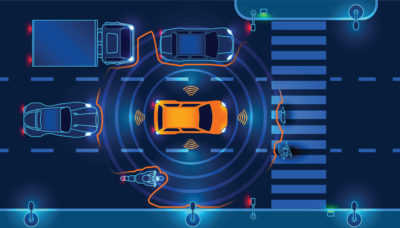By Gregory Winfree and Larry Head
 Perhaps you’ve envisioned your commute someday involving a self-driving car. But imagine if that futuristic ride not only could drive itself, but also could communicate with other cars, sharing vital safety signals.
Perhaps you’ve envisioned your commute someday involving a self-driving car. But imagine if that futuristic ride not only could drive itself, but also could communicate with other cars, sharing vital safety signals.
We’re a significant step closer to that future, thanks to a recent announcement by Toyota and Lexus and the early adoption by General Motors on the 2017 Cadillac CTS. Beginning in 2021, Toyota and Lexus will include systems on cars that enable those signals by using Dedicated Short Range Communication (DSRC) on a radio frequency set aside for that purpose. This move is both timely and essential, but it should be accompanied by government steps to keep the spectrum reserved for transportation safety and not allow competition by non-safety interests.
What’s DSRC all about?
DSRC is part of a communications frequency dedicated in 1997 by the Federal Communications Commission and by Congress. That spectrum was allocated in part to provide for the intelligent transportation systems envisioned at the time.DSRC is a life-saving technology, able to transmit a safety message 10 times per second, far more quickly than the two or three seconds that human drivers need to react to a roadway hazard. Those car-to-car safety messages can enable, amongst other alerts:
- Left turn gap assist
- Blind spot do-not-pass warnings
- Electronic emergency braking
- Forward collision warnings
- Red light runner alerts
- Work zone advance warnings
- Emergency vehicle alert
What’s at risk, and why?
Radio frequency spectrum is finite, like shelf space in your grocery store, and wireless companies covet spectrum reserved for DSRC to instead accommodate wireless devices intended to speed data communications for entertainment and other end uses. So rather than implementing safety technology under development since 1997 now, wireless companies want to put nascent 5G technology to work as an alternative to DSRC for transmitting connected-car safety messages.
From a practicality perspective, a recommendation to supplant DSRC with 5G has nothing to do with the underlying technology and everything to do with the inevitable delay — and continued loss of life on our roadways — as 5G technology is readied for widespread implementation.
The rapid expansion in internet usage requires that Wi-fi is always quickly within reach, so, clearly, the need for additional Wi-fi capacity is real. But the life-saving capabilities of DSRC – the product of an international research and development collaborative involving global automakers, leading research universities and governmental research entities — are real as well.
We believe the cost/benefit analysis markedly tips in favor of saving lives, thus a decision to maintain DSRC spectrum as one dedicated to transportation safety should be evident on its face.
Some contend that the limited spectrum can accommodate sharing among multiple interests. We regard that argument as specious, because life-saving connected-vehicle safety messages should not have to compete for spectrum primacy with speedy feature film downloads.
While 5G holds promise and should be among a suite of suitable technologies when fully tested and available in the marketplace, it’s not yet ready for prime time as a DSRC substitute.
That point was made clearly in a Jan. 23 letter from the Coalition for Safety Sooner to U.S. Transportation Secretary Elaine Chao, Federal Communications Commission Chairman Ajit Pai, and Office of Management and Budget Director Mick Mulvaney. As the Coalition’s members point out, DSRC is the only currently available technology to support connected vehicle safety applications; no other wireless technology can do so at this time.
Why DSRC, and why now?
The safety messages enabled by DSRC can help to prevent up to 80 percent of the roadway crashes that don’t involve impaired drivers. According to the National Highway Traffic Safety Administration (NHTSA), 37,461 lives were lost on U.S. roads in 2016. The sooner that DSRC is implemented, the sooner we can begin to prevent up to 20,000 roadway deaths a year, along with their immense emotional toll and the $800 billion yearly cost of U.S. car crashes.
We are encouraged by the commitment from GM, Toyota and Lexus to put DSRC and a dedicated spectrum to work in the interest of safer, connected transportation. Their pledge should now be reinforced by government efforts to protect the spectrum from any intrusion that could compromise its original life-saving purpose.
Gregory Winfree, J.D. is the agency director of the Texas A&M Transportation Institute and a former U.S. assistant secretary of Transportation.
Larry Head, Ph.D. is the acting dean of Engineering and the director of the Transportation Research Institute at the University of Arizona.
This article was originally published in The Hill, June 12, 2018.